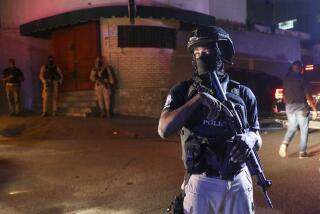Violence against aid workers has surged, report says
- Share via
Reporting from Kabul, Afghanistan — Violent attacks against humanitarian aid workers have tripled during the last decade, with more than 100 deaths reported annually, according to a study commissioned by the United Nations.
The report shows that the highest toll has been among aid workers in areas of armed conflict, including Afghanistan, Sudan and Somalia. Since 2005, there have been 180 major attacks against aid workers in Afghanistan, 150 in Sudan and 100 in Somalia, according to the report released this week called “To Stay and Deliver.”
The increased violence comes amid a proliferation of nongovernmental aid groups, including 280 in Afghanistan, said former U.N. humanitarian chief Jan Egeland, who along with two security experts conducted the report for the U.N. Office for the Coordination of Humanitarian Affairs.
Foreign workers have faced outrage in Afghanistan since a Florida pastor burned a copy of the Koran last month. The Koran burning sparked a deadly protest April 1 in the northern city of Mazar-i-Sharif in which gunmen stormed a U.N. compound, killing three U.N. staff members and four Nepalese guards.
“There are no places on Earth where humanitarian organizations should not go or cannot go,” Egeland, now director of the Norwegian Institute of International Affairs, said Tuesday during a press conference in New York. “Instead of asking what does it take to leave, we should ask what does it take to stay in Mazar-i-Sharif and other such places. Risk management means you adapt to the circumstances.”
Dan McNorton, a spokesman for the U.N. in Afghanistan, said the report reflected the increased security risks the world body’s staff has faced in recent years.
“Physical security measures are of course vital, but there are also other steps we take to ensure the security of our personnel,” McNorton said, including, “maintaining our relationships with local people.”
Egeland said the report, based on interviews with more than 250 aid workers, shows the importance of granting aid workers access to all parties to a conflict, including the Taliban.
He praised the International Committee of the Red Cross but criticized what he called the “bunkerization, politicization and militarization” of other humanitarian workers in places such as Afghanistan and Iraq, where some aid groups have hired armed guards and accepted military funding for counterinsurgency work, putting other humanitarian organizations at risk of attack, he said.
Aid agencies should consider hiring local plainclothes police officers, taxis, or unmarked cars, the report suggests, and focus on becoming “more professional, more disciplined and more principled in how they act and how they enforce principles and standards in high-risk circumstances.”
Santa Monica-based International Medical Corps has worked in Afghanistan since 1984, but as security has deteriorated, staff members have struggled to maintain their reputation for neutrality, said spokeswoman Margaret Aguirre.
“We are seen as a soft target by people who do not want to see communities succeed or who believe that just because we are a foreign NGO we are linked to the foreign policies of Western countries,” Aguirre said.
“But we have managed to deal with it so far by increasing the community’s acceptance of us and knowledge of what we do, increasing community participation in our work and keeping a low profile.”
molly.hennessy-fiske@latimes.com
More to Read
Sign up for Essential California
The most important California stories and recommendations in your inbox every morning.
You may occasionally receive promotional content from the Los Angeles Times.











